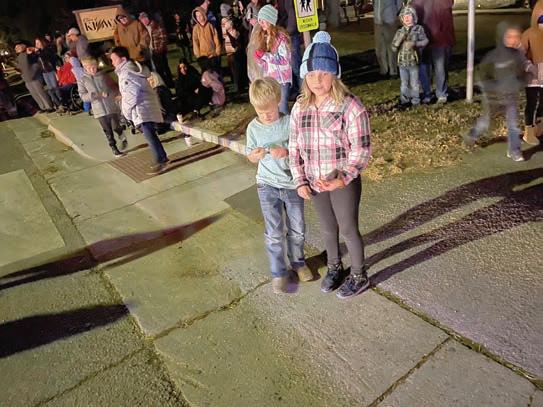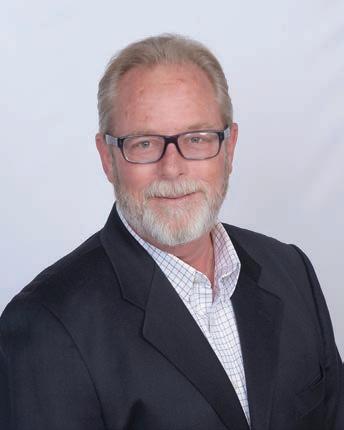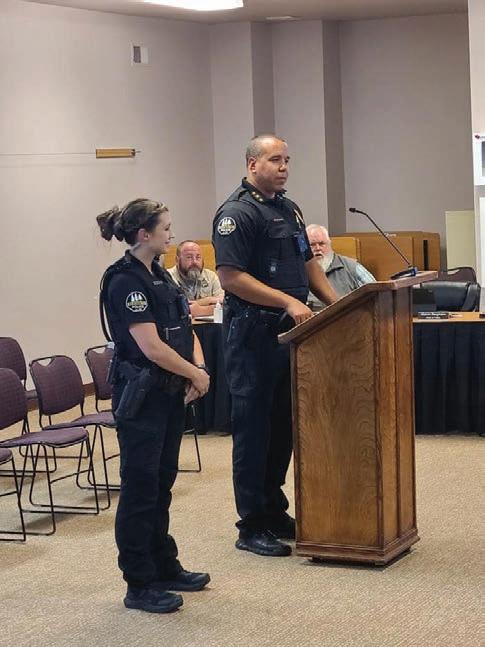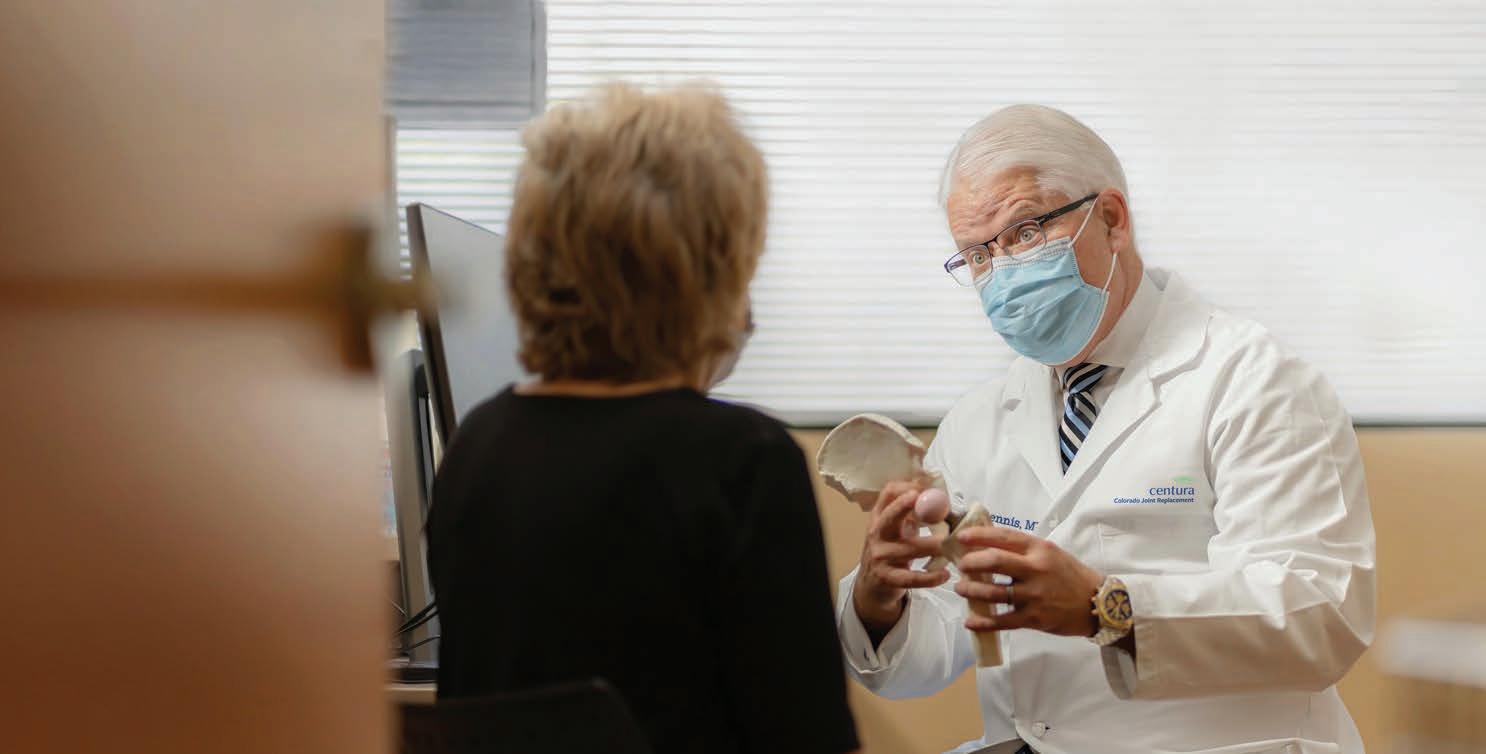Hundreds of people gathered recently for the yearly Kiowa Christmas Extravaganza at the Elbert County Fairgrounds.




Hundreds of people gathered recently for the yearly Kiowa Christmas Extravaganza at the Elbert County Fairgrounds.









 BY CHANCY J. GATLIN-ANDERSON SPECIAL TO COLORADO COMMUNITY MEDIA
BY CHANCY J. GATLIN-ANDERSON SPECIAL TO COLORADO COMMUNITY MEDIA
In the new year, Elbert County will welcome its new commissioner for District 2, Dallas Schroeder, who is currently the county’s clerk and recorder.
Schroeder will be taking over the District 2 commissioner role from Rick Pettitt, joining Chris Richardson of District 1 and Grant Thayer of District 3. District 2 encompasses the three municipalities of Elbert County, the towns of Elizabeth, Kiowa and Simla.
As a new commissioner, Schroeder will serve a fouryear term. There is currently a two-term limit for commissioners. As commissioner, Schroeder will be responsible for budget and financial oversight, land use issues and decisions, and setting the general philosophy and direction of Elbert County government, among many other things.
Schroeder did a Q&A interview with the Elbert County News on Nov. 29, sharing his reasoning for running for commissioner, his goals for Elbert County, and a little bit about who he is outside of his roles in county government.

How does it feel to be the next District 2 commissioner-elect? Though you were running unopposed, was it still exciting to be elected?
I am looking forward to continuing to serve the citizens in this new role as commissioner. It is a responsibility that I do not take lightly. I am grateful to the citizens of Elbert County who expressed their trust by voting for me. It is easy to leave an unopposed contest blank but to have over 12,000 citizens cast their vote for me indicates a great confidence the citizens have in me. I won’t let them down.
Why did you want to run for commissioner?
Knowing that I would be termed out of my current position as clerk and recorder created a question of what would be next. When Commissioner Pettitt publicly announced he would not run for a second term, I saw an opportunity for me to continue to serve Elbert County. I would not have run against Commissioner Pettitt as I respect his service to this county and consider him mentor and a friend. I believe my experience as clerk and recorder has prepared me for the role of commissioner.
The goals would be for the entire county, as commissioners are elected by the entire county and serve the entire county. One of our hallmarks within the clerk’s office is that we are here to help and serve the citizens, regardless of the department. We work with the citizens, often going the extra mile to help them complete their business. Our goal is to be a knowledgeable guide to assist them, not be a bureaucratic impediment. I’m not saying that is not happening throughout the county, but I want it to continue to be a top priority for all departments.

Many things in the future will be out of our complete control. The national economy is tottering on a major economic downturn. Inflation has impacted all our citizens and the county budget as well. I applaud the current commissioners
for creating those rainy-day funds that will help lessen the effects on services for the citizens. There will be tough decisions coming our way, but these funds will help and need to be utilized strategically and wisely.
Growth is going to take place. I believe it is better to plan and be proactive with the growth that is inevitable instead of reacting after the fact. I agree with the Economic Development Zone concept of streamlining and encouraging economic development in the county. Counties are either growing and expanding or declining. We need to prepare, plan, and guide that growth when appropriate, while still respecting private property rights.
With that being said, elected positions are often defined by events no one saw coming. I am a steady, common-sense leader who isn’t afraid to tackle problems head-on and make decisions. So, for whatever event is in the future we know not of, that is my demeanor and style and I believe that will serve the future of the county well.
Are you looking forward to working with Richardson and Thayer? Do you have any thoughts on how you hope to integrate into the BOCC with them?
I do look forward to working with Commissioners Richardson and Thayer. When they arrived, they brought order and stability to an atmosphere that was at times pretty chaotic. I appreciated that endeavor and will continue to work to maintain that order and stability. My perspective of being
in county government for almost nine and a half years will be the perspective I can bring to the table. I have worked with them in my current capacity for six years and believe we have the same goals for the county.
Anything you want to make sure the people of Elbert County know about regarding your upcoming role as Elbert County commissioner?
Communication is always a key ingredient for any organization. I encourage the citizens to come ask questions directly instead of assuming or taking the rumors that float around as fact. We may not always agree but open, honest, and respectful communication is important for understanding on all sides.
As outgoing Elbert County clerk and recorder, what do you feel are your greatest accomplishments while in the position?

I’m very proud of the accomplishments within the clerk and recorder’s office over the past nine and a half years.
Soon all our recorded documents back to 1874 will be available online. No longer will citizens have to come to the office to get the documents they need. A grant was obtained to digitize all our recorded documents. Not only will this make searches easier for citizens but will help preserve our original books.
The Clerk to the Board duties have been greatly enhanced with the onboarding of Civic Clerk software that streamlines the meeting
Life’s setbacks can be hard for individuals and families struggling to make ends meet. That’s why Catholic Charities Castle Rock offers programs, services, and community partnerships to help people regain stability and thrive.

Help prevent homelessness. Visit CCharitiesCC.org.
agendas, publishes agendas and meting notifications to those who wish to receive them and integrating online video recording and viewing of meetings. This greatly enhanced transparency and made access easier for those who wanted to be up to speed on the activities of county government.
The election department goes the extra mile to verify our election results, both for our and the citizens’ peace of mind. In our republic, the right to vote and be assured that those votes are tabulated correctly is a foundational piece to the confidence people have in their elected leaders. The elections department does everything in its power and often exceeds state minimums to have that assurance.
The motor vehicle department routinely exceeds $1 million in revenue every month. When I started, $600,000 was a big month. Roughly half of those funds are sent to the state. The last two surveys conducted by the county revealed the MV department as the top customer service department in the county. We are proud of that.
I was active in the acquisition and moving the department to the Samuel Elbert Building. There were some who criticized the decision but that has proven to be a great decision for the county. While many other counties had to shut down services during the pandemic, we were able to serve our citizens in the drivethrough, the only one in the state. We processed motor vehicle transactions, recorded documents, married people, accepted tax payments and registered new voters, all through the drive-through windows.
I will miss all the different aspects to the clerk and recorder position. Each day is different. Most of all I will miss the amazing ladies in the clerk’s office. My time working with them will always be special to me.
What is your home life like? Wife? kids? What do you do for fun when not helping run the county?
My wife, Rebecca and I celebrated 30 years this past June. We have three adult children and a new grandson. We are active members at Elbert Christian Church. I enjoy watching baseball and football. I love to hunt and fish.
To learn more about the Elbert County commissioners or to contact them, visit elbertcounty-co.gov/256/ Commissioners.


The celebration on Nov. 26 drew people from around Elbert County, kick-starting the festive holiday season. The event took place at the Elbert County Fairgrounds followed by a short parade by first responders and the tree lighting at city hall.



From noon to 5 p.m., several activities took place including the 4-H tree and wreath sale, the Kiowa Schools craft fair and the themed Christmas tree contest. There were also several children’s activities including large inflatables, craft and drawing tables, and the opportunity to tell their Christmas wishes to Santa and Mrs. Claus. SEE CHRISTMAS, P4
Douglas


Many services are available at DoItOnlineDouglas.com
Information nights are free and open to anyone interested in learning about foster care and adoption. Join the meeting via Zoom on Dec. 10 from 9-10:30 a.m. or Dec. 19 from6-7:30 p.m. Call 303-636-1KID for more information, or to register online, visit collaborativefostercare.com




Renew your driver license or motor vehicle registration and more from the convenience of your smartphone, tablet, desktop or laptop. You can also renew vehicle registrations at MVExpress kiosks. Find information at DouglasDrives.com

Do you ever wonder how county roads are prioritized for snow removal? Questions about citizen snow removal responsibilities? Answers to these questions and more can be found by visiting douglas.co.us and searching for Snow Removal.
Eligible low-income households in Douglas County may apply for energy assistance through the Low Income Energy Assistance Program (LEAP). Visit douglas.co.us and search LEAP for more information or an application, or email LEAPHELP@discovermygoodwill.org
Our mental and emotional health is just as important as our physical health, and it’s important for us to connect with others. Simply talking with someone can make you, and them, feel better. Learn how to start the conversation today by visiting letstalkco.org or hablemosco.org
Our commitment to open and transparent government includes online posting of information about public meetings at which the business of government is conducted. To view public meeting agendas, participate in-person or remotely, or watch select meetings via live stream, visit douglas.co.us and search for Business Meetings / Public Hearings.
A highlight of the event was the presence of therapy dogs from Healing Hounds of Colorado. The dogs excitedly walked around the event greeting children along the way. K9 Frankie, a treeing walker coonhound, was exceptionally welcoming of pets from the eager children.

Frankie’s handler, Laura Kissinger, also works with the Elbert County Coalition for Outreach (ECCO) that worked to help organize the Kiowa Christmas Extravaganza. As kids surrounded her to pet Frankie, she shared her thoughts on ECCO’s role at the event.




“This is the fifth year we’ve done this,” said Kissinger. “This event is one way to let everybody know that there are resources available to them in Elbert County. And for those who





















SEE CHRISTMAS, P5




After 5 p.m., celebrants gathered on the grass of Kiowa Town Hall in preparation for the official Christmas tree lighting. The town provided coffee and hot chocolate, which people enjoyed while listening to Christmas music.


“We’d like to thank the Town of Kiowa and those that brought Santa to us this year,” said Mayor Rick Kolm before the tree lighting. “Christmas is about community and kids. We appreciate those of you that support the Town of Kiowa and making it a better place to live, because Elbert County rocks.”





To learn more about Healing Hounds of Colorado, visit











Elizabeth Police Chief Melvin Berghahn resigned on Dec. 1 after a seven-year career with the department. His resignation was effective immediately and the Town of Elizabeth and the police department began working to determine a plan of action moving forward.
Berghahn, who was sworn in as chief on Jan. 15, 2021, had risen through the ranks of the Elizabeth Police Department. After nine years in law enforcement elsewhere, he joined the Elizabeth department as a sergeant in 2015 and was named commander in 2018. Berghahn promoted diversity and advocated for those in need during his time as chief.


Following Berghahn’s resignation, Elizabeth Police Sgt. Sean Bigler was placed in charge of daily operations of the department pending the appointment of an interim police chief, according to a Dec. 2 email from Town Administrator Patrick Davidson.

Davidson himself is handling the department’s non-lawenforcement administrative duties during that time, he wrote.
In an interview with the Elbert County News shortly after his resignation, Berghahn expressed his gratitude for his time with the Elizabeth Police Department.
“It has been an honor working for the citizens of Elizabeth. My time with the officers can never be replaced. To them, I give my gratitude and thanks. Their hard work and proactive policing is unmatched and I will always cherish my time with them,” said Berghahn. ‘The sergeants, corporal and records manager have been the foundation for my growth and development. Without them, the many accomplishments of the department would never have been. The town administration and town board have shown care and support for my development, and I will miss everything and everyone more than they can comprehend. Finally, I would like to thank the citizens of Elizabeth for allowing me to be their police chief and for trusting in me and supporting my visions.”
Berghahn said he is leaving the department to pursue other opportunities, get married, and focus his attention on his family.
The town released a statement saying: “The Mayor and Board of Trustees for the Town of Elizabeth want to announce the resignation of Melvin Berghahn as the Chief of Police. Melvin began his service with the Town of Elizabeth in 2015 , and has held the positions of Sergeant, Commander, and Chief. In these roles, he was instrumental in the creation and development of the Student Police Academy, bike patrols, and the growth and development of the Department. His willingness to help the youth and elderly in the community, both inside and outside of his official duties, was remarkable. The Mayor and the Board of Trustees wish to thank him for his years of service, his dedication to the community, and wish him the best in the future.”

Davidson, the town administrator, described the town’s next steps to the Elbert County News on the day after Berghan’s resignation.

“For the next week or so we’re reaching out and looking for an interim chief of police,” he wrote. “Soon we’ll run a search (maybe regionally, statewide, or nationally, that hasn’t been decided yet) to find a permanent replacement. We should have an answer in that regard in the next couple of days. We will do what we do and ensure that the citizens’ needs are met. We’ll be working with other law enforcement in the area. We wish Melvin all the best. We’re going to actively look for a chief that will fit with the town. We’ve got a little town that’s growing and we want to find the best for it. “
Riley Thompson, a 2022 Elizabeth High School graduate who was a four-year student of the Police Academy and has gone on to volunteer with the organization, also weighed in on Berghahn’s resignation.
“That’s incredibly sad,” she wrote. “He was a great guy and definitely opened a lot of eyes into policing. He was very fun. Even before he was chief. He came into chief position when I was in my second year at the academy and although he did start being at the academy less and less he still made sure everything was going well. He was just a nice guy who was always fun to be around. “





















Colorado elementary and middle school students attending charter schools excelled in literacy and math at higher rates than their peers at traditional public schools throughout the pandemic, bucking a national trend, according to a report published by the nonpartisan Keystone Policy Center.
The numbers are particularly positive for charter schools that educate a significant share of kids from low-income families, the report notes, indicating that Colorado charter schools have been more effective in keeping some of the state’s most vulnerable students on academic pace during COVID-19.


However, many elementary and middle schoolers enrolled in charter schools across the state are still falling short of meeting state academic standards, the report reveals.
“Charter schools, as is the case






problem, not just in Colorado but nationally. We need to frankly rethink how we’re doing public education and how we fund it and how it’s organized because if we have a system that can’t get most kids to standard, then either the standards are wrong — which I don’t think they are — or the system is totally messed up. And we’ve been working on this for decades.”
Dan Schaller, president of the Colorado League of Charter Schools, is encouraged by the achievement of Colorado charter schools but acknowledges that they have more progress to make.
“I think it’s important to remember it’s against the backdrop of us needing to do a lot of work in the public education system in general,” Schaller said.
The report evaluated how schools are ranked on state accountability measures, known as School Transitional Frameworks, and looked at
students, according to Schaller. Charter schools are public schools managed by outside nonprofit operators that establish a performance contract with a school district, which serves as the authorizer. The contract gives charter schools more flexibility than traditional public schools over how they educate children, but they are still subject to the same standards and assessments as traditional public schools. Charter schools are often born when families and communities recognize the need for a high-quality alternative and band together to create an application for a charter school with a different model than what their districtrun schools offer, Schaller said.
“In many respects, they’re more accountable, but they are given the flexibility to have the school-based control over decisions related to staffing, decisions related to budgeting, to academic programming,” he said.
The report from the Keystone Policy Center notes that 85% of charter school students go to a school that earned the highest rating on the School Transitional Frameworks — the “performance” rating. Meanwhile, 66% of traditional public school students are enrolled in a school that is rated “performance.”
At schools serving students living in poverty, the gap is much greater.
Two-thirds of charter students learning at schools with mostly kids from low-income families were at schools rated “performance” while 19% of students at traditional public schools where the majority of students are poor were enrolled in a “performance” school, the report stated.
“These do represent some of the largest gaps that I’ve seen,” Schaller said.















Charter school students in grades 3-8 fared better on literacy
school students — compared with school students — meeting or surpassing grade level benchmarks in English language arts. In math, 31% of charter school students met or surpassed grade level benchmarks, compared with 27% of kids in district-run schools, the report notes.
Additionally, elementary, middle and high school students attending charter schools demonstrated greater levels of academic growth in both English language arts and math than kids at district-run schools.
The academic gains made by charter schools during the past year built on momentum from the years leading up to the pandemic, captured by the Colorado Department of Education’s 2019 State of Charter Schools Triennial Report. That report, released in March 2020, details that charter school students consistently outperformed students from non-charter schools on CMAS English language arts and math exams from 2016-18. Similarly, charter school students performed better on PSAT and SAT evidence-based reading and writing and math exams during those three years than their peers at non-charter schools.
The report, published once every three years, also illuminates the demographics of students attending Colorado charter schools. In 2019, charter schools educated more students of color and more students learning English than other Colorado schools, but fewer students with disabilities and fewer students who qualify for free and reduced price lunch — a federal indicator of poverty.
Schaller attributes at least part of charter schools’ success to how responsive they are to their students and families.
The charter school model is “inherently flexible and adaptable to the needs of a given school
community,” said Schaller, who sees charter schools’ control over decisions driving much of their achievement.
The pandemic has highlighted “the power of a system of public school options for kids,” he said.

“Our kids aren’t all the same,” Schaller said, “and our schools shouldn’t be either.”









“An important part of the mix”
Another hypothesis related to charter schools’ higher achievement rates: how much time students spent in school and what happened when they weren’t in classrooms.
“It could have been that charter school kids were less out of school and … built more community when they were out of school than other district schools, and so when they came back, they may have been more ready to learn,” said Schoales, of the Keystone Policy Center. “And it also is possible that they may have had more summer opportunities or tutoring opportunities.”
When it comes to the success that charter schools have demonstrated in helping kids from lowincome families make academic gains, Schoales suspects that charter schools are often set up to better serve specific groups of kids from the get-go.
“My theory is … because often schools are designed to serve a particular group of kids that they may be better at that because they go in with the intention of doing that,” Schoales said.
He added that charter schools are often smaller, and therefore can be more nimble and responsive. There is also often more communication with parents — who are key to their children’s academic outcomes — in charter schools than in district-run schools, Schoales said.
And yet, charter schools often are operating in poorer quality facilities with fewer funds, lower teacher pay and higher staff turnover, he noted.
“It does suggest that whatever the charters are doing, they’re doing it in spite of having often higher turnover and lower paid teachers,” Schoales said. “So what would happen if they had teachers paid at the same rates?”
While charter school students are achieving at a higher rate than their counterparts in districtoperated public schools, more than half of all students are still trailing behind grade level standards in math and literacy.
“I don’t want anybody to come away from this saying, ‘Oh gosh, you know, charter schools are solving our educational challenges,’ and they’re not,” Schoales said. “They’re just doing better than the district schools, at least for this year.”
Their struggles are reflective of broader challenges schools have faced in keeping kids on academic track amid the pandemic, with disruptions — including lost time in the classroom and frequent transitions between in-person, hybrid and remote schooling — interfering with students’ ability to learn.
Students’ grasp of math has become a particular point of concern for educators, education advocates and even state leaders, with less than a third of Colorado elementary and middle school students meeting or exceeding grade level benchmarks and less than 35% of 11th grade students meeting or exceeding college readiness targets in math on the SAT.
Across the country, student declines in academic performance ran parallel in charter schools and district-run public schools, according to reporting on scores from the National Assessment of Educational Progress by Chalkbeat.
One reason that Colorado charter schools may have defied national trends is the balance the state has struck between the flexibility and autonomy it provides charter schools and the accountability it enforces on them, Schaller said.




Part of that accountability involves particularly high stakes: Authorizers — school districts — will move forward with closing charter schools if they’re not performing well, Schoales said, incentivizing charter schools to make sure students are reaching academic standards.
But charter school students don’t outperform their peers at district-run schools in every area, according to the report. For instance, SAT results show that 46% of 11th-grade students at charter schools met or surpassed grade level expectations on the English language arts assessment, compared with 50% of students attending traditional public schools. In math, one third of 11th grade students in both charter schools and district-run public schools met or surpassed grade level benchmarks.
There is also significant variation in academic performance among Colorado charter schools, similar to the wide variation in performance among district-operated public schools — discrepancies that are worth more investigation, the report states.

Schoales points to variations in funding, compensation, educator backgrounds and the educational design of charter schools as the reasoning behind the differences in their academic performance.
He also sees charter schools continuing to have a polarizing effect on educators, families and communities, with some lauding them and others vilifying them. He hopes that the more that research on charter schools emerges, the more that people will understand that “charter schools are an important part of the mix, and they sometimes serve kids better, and sometimes they don’t.”
And Schoales wants to veer away from the chronic political debates over whether or not charter schools should exist to focus on what he believes is a more worthwhile question.
“Instead, let’s talk about, where can we get some good schools?”







This story is from The Colorado Sun, a journalist-owned news outlet based in Denver and covering the state. For more, and to support The Colorado Sun, visit coloradosun.com. The Colorado Sun is a partner in the Colorado News Conservancy, owner of Colorado Community Media.
JAN 13 - FEB 4 | PACE Center SENSORY-FRIENDLY PERFORMANCE JAN 22


















































Parker Arts presents one of the most beloved musicals of all time! In Austria, 1938, an exuberant young governess brings music and joy back to a broken family, only to face danger and intrigue as the Nazis gain power. Featuring a trove of cherished songs, The Sound of Music earned five Tony® Awards and five Oscars® and continues to win the hearts of audiences worldwide.
SOUND OF MUSIC is





















































































www.concordtheatricals.com



Out of thousands of nurse educators in the country, one of the top five is right here in Colorado.
Tammy Spencer, DNP, RN, has dedicated most of her life to nursing. She has taught at the University of Colorado College of Nursing for over 30 years. Earlier this year, she was honored with the National League of Nursing’s “Nurse Educator of the Year” award.
“I can think of several times in the past three months that patients have had an impact on me,” said Spencer. “I mean, you can’t help but be moved by their stories, and you can’t help but feel such an honor and privilege to be with that person at one of the most vulnerable times in their lives.”
Spencer was nominated by her nursing colleagues and friends, Gail Armstrong and Peggy Jenkins.
Armstrong said Spencer has been honored with 18 awards since she became a faculty member and completed her master’s degree at the University of Colorado College of Nursing in 1989.

“For Tammy to be identified as one of the top five nurse educators in the country is a really, really prestigious award,” Armstrong added.
Armstrong said Spencer’s award
did not come as a surprise to her colleagues and students. The nursing school’s Facebook page was flooded with heartfelt comments congratulating her.
“Tammy Spencer is one of the absolute best out there! She lives her passion for nursing,” one commenter wrote. “I feel blessed to have been one of her students!”
“So well deserved,” another person said. “She’s one of my favorite professors I’ve had out of all three of my degrees.”

One of Spencer’s students, Barbara Klontz, shared that Spencer’s teaching style is the reason she can understand complicated topics in school.
“Tammy is about a couple of things: kindness, always — she has a really bright personality and lots of energy — but also she really likes being with people and she treats everyone ... like they’re a friend or a close acquaintance, so it’s really easy to be with her,” Klontz said.
Spencer said her passion is teaching.
“My students bring me a lot of joy,” she said, “to be in the classroom and to be able to really impact them in such a profound way, to think that you are educating the next generation of nurses.”
Spencer said another passion of hers is policy-making; she explained that she was involved with getting emergency orders signed by Governor Jared Polis to “help lessen burdens of clinical hours required for graduation.” Spencer said she
did this because it helped “fill the pipeline at a time when nurses were leaving” during the COVID-19 pandemic.
“I think that more and more policy is needed around nursing. I think nurses have a huge voice in health care,” Spencer said. “We need to use that voice; we need to feel empowered to use that voice.”
Spencer lives by a mantra written by Virginia Henderson, a renowned nurse, writer and scholar.
“[Henderson] described nursing as, ‘nursing is work of the head, work of the heart and work of the hands,’” said Spencer.
Spencer believes one cannot get into nursing without “being passionate.”
“You are handing a newborn for the first time to a mother, you are holding the hand of a patient that’s dying. You can’t help but be moved by that,” Spencer said. “So, that’s what nursing means.”
This story is from Rocky Mountain PBS, a nonprofit public broadcaster providing community stories across Colorado over the air and online. Used by permission. For more, and to support Rocky Mountain PBS, visit rmpbs.org.
Our award-winning team focuses solely on total knee and hip replacements. And our research has developed ways to get you back out there faster.


Call 720.524.1367 to schedule an in-person consultation. | ColoradoJoint.org Centura Health does not discriminate against any person on the basis of race, color, national origin, disability, age, sex, religion, creed, ancestry, sexual orientation, and marital status in admission, treatment, or participation in its programs, services and activities, or in employment. For further information about this policy contact Centura Health’s Office of the General Counsel at 1-303-673-8166 (TTY: 711). Copyright © Centura Health, 2022. ATENCIÓN: Si habla español, tiene a su disposición servicios gratuitos de asistencia lingüística. Llame al 1-303-643-1000 (TTY: 711). CHÚ Ý: Nếu bạn nói Ti
711).
Joint
reunites you with the activities you love.Tammy Spencer serves as an inspiration to the next generation of nurses. ROCKY MOUNTAIN PBS PHOTO
YS: Girls Basketball 9-10 @ Harvard Gulch
@ 12am
Dec 15th - Mar 9th
Harvard Gulch Recreation Center, 550 E. Iliff Ave., Denver. 720-913-0654
YS: Girls Basketball 11-12 @ Cook Park
@ 1am
Dec 15th - Mar 9th
Cook Park Recreation Center, 7100 E. Cherry Creek South Dr., Denver. 720-9130654
YS: Boys Basketball 13-14 @ Eisenhower @ 1:30am










Dec 15th - Mar 10th
Eisenhower Recreation Center, 4300 E. Dartmouth Ave., Denver. 720-913-0654 CW & Twenty Hands High @ 7:30pm Tailgate Tavern & Grill, 19552 Mainstreet, Parker


YS: Girls Basketball 9-10 @ Eisenhower @ 12:30am
Dec 16th - Mar 10th
Eisenhower Recreation Center, 4300 E. Dartmouth Ave., Denver. 720-913-0654
YS: Girls Basketball 9-10 @ Cook Park @ 1am
Dec 16th - Mar 10th
Cook Park Recreation Center, 7100 E. Cherry Creek South Dr., Denver. 720-9130654

Modern
Denver MountainAirs Colorado Cord Co @ 2:30am Dec 21st - Dec 20th


Heather Gardens Clubhouse, 2888 S. Heather Gardens Way, Aurora
Ladies Night @ 6pm / $5 Stampede, 2430 South Havana, Aurora


AOA: Cooking with Friends: Holiday Cookies @ Eisenhower @ 7pm
Eisenhower Recreation Center, 4300 E. Dartmouth Ave., Denver. 720-913-0654
DJ



Parker Fieldhouse, 18700 E Plaza Dr., Parker. 303-805-6315

Lincoln Station Coffee/Pizza/Music, 9360 Station St, Lone Tree


When you need some good ole basic rod and reel fishing advice you have a lot of sources, not the least of which is our helpful State Parks & Wildlife pros. Add to that group your longtime personal fishing buddy, maybe that agent you have come to like at the nearby sporting goods shop. You can even look beyond this circle, as I did, and discover someone in the neighborhood rumored to spend a lot of time wading lake shorelines or in casting from fishing boats. I discovered long time Westminster resident Don Goodman, a gentleman busy in his church with a “year around” fishing calendar marked heavily with his numerous angling outings. Unlike many anglers, Don’s fishing season does not end with the summer season. He is not one that stores his rods when the aspens turn gold, and the fall chill of winter settles in the foothills and along the Front Range.
“December is the slow, quiet month
for me,” Don stated. He patiently waits for summer lake waters to cool and ice over. December is a good month for Don to tackle the angling gear repairs and check out fishing catalogs and sporting goods shops for the latest new fishing gear and technology.
Don frequents both cold water mountain lakes and warm water eastern slope reservoirs year around. His choice of lake baits includes night crawlers, liver, or sucker meat, fished off the bottom of the lake in a slow and varied jigging action. Carefully selected lures are equally popular in Don’s tackle boxes. Both are activated in slower movements to match the slower movement of the fish in the colder winter water temperatures. Don uses similar gear and seeks out similar water depths and environments in both summer and winter.
“To offset slower movement of fish in colder water I slow my speeds jigging or drifting.” he confirmed.
Don pursues fish at both eastern lakes like Jackson Lake, Boyd Lake, Pueblo Reservoir and Aurora Reservoir, and high-country mountain lakes alike in South Park and Grand County. He enjoys exceptional success at Sandpiper, Blue Heron, and Coot ponds at the St. Vain State Park ponds near the Longmont-I-25 exit. Closer
into the mountains he enjoys success at Evergreen, Chatfield, and Bear Creek Reservoirs, both are younger waters with closer destinations.
“I have learned the challenge and value of matching, sometimes experimenting, the baits to lake depths and temperatures as the season moves into the early spring. Don encourages this process and has found the result productive to his catching success. Studying a lake for habitat, structure and plant growth is essential. Equally helpful is the fact this process leads an angler to where the fish are schooled.
South Park area reservoirs Antero and Eleven Mile, near the town of Fairplay, tends to attract Don early in the spring. An influencing factor are due primarily to the shallower depths and a faster warming of the water.
Don takes an active role in big fish challenges. His choice waters in the high mountain waters are Granby Reservoir and Willow Creek Reservoirs in Grand County and nearby Lake John near Walden.
“Lake trout, Larger mackinaw and mature rainbow and German Brown trout cruise deeper waters, normally at slower feeding times, requiring similar varied jigjig movements to attract the larger fish,” Don reminds us.
Bait and lure experimenting
should be on our year around agenda whenever fishing slows regardless of where we are fishing. The popular and uncomplicated Mepps spinner or bright cast master with or without worms or sucker meat is a good example of one menu of choice for trout in the mountain lakes. Don is convinced there is a definite connection between a lakes natural bug species, aquatic growth, habitat and structure, and the angler’s lure types. Finding that connection is worth the study time.
Don’s confident presence takes on an excitement and big smile when you ask him about his recently awarded “Master Angler” award received last year from the Colorado Division of Parks & Wildlife. Don proudly landed a four-pound smallmouth bass, which comfortably exceeded the three plus pound smallmouth previously on record. The trophy was taken in late fall from an eastern plains warm water pond.
Don genuinely enjoys watching people pursue the sport of fishing and to do so with success. And he suggests fishing can really be a fun year-round experience.
Outdoorsman and Westminster resident Ron Hellbusch can be reached at Ron-Hellbusch Comcast.net
She had gone out for a run, and it wasn’t until she was more than a half mile away before she realized that she had left her phone at home. The reason she became aware of the missing phone was because she felt just a little bit lighter. The average cell phone weighs under 0.5 pounds and as she returned from her run, she thought about why she could feel such a slight difference as she ran.
As she shared her story with me, we began creating a list of possibilities for how such an insignificant amount of weight could have had such a noticeable impact. We tossed around ideas that had more to do with the size of the device and not the weight and how that may have prompted her to notice that her phone was missing. And then we kicked around a few silly ideas before settling on what was
probably the real reason.
She started to talk about all the things she has on her phone, everything from several screens loaded with dozens of apps, several games, tens of thousands of photos, workrelated tools such as her email and calendar, and all the social media platforms. Among her apps were at least 10 news feeds which she checked regularly. We hypothesized that although none of these carry any physical weight, they certainly carry with them emotional and stressful weights that when we don’t have access to them for even the shortest amount of time, we can begin to feel a little lighter and the world seems a little brighter.
Maybe we can all relate to this a little bit when we think about all the weight that comes with our own cell phones that we carry. The need to be in the know at all times about what is happening with our family and friends. Feeling obligated to check every email or text and respond immediately. Experiencing withdrawals if we do not open our news feeds to
LINDA SHAPLEY Publisher
lshapley@coloradocommunitymedia.com
make sure we know what is going on in our town, state, country, and around the world. And not only making sure we check the news, but we also must check multiple sites to try and find the truth as we never know who or what to believe.
As we continued our conversation, going into the details of what is contained on her phone, she realized just how heavy that phone really was. And to run for a few miles without it and feel just the slightest bit lighter now made all the sense in the world. She made the commitment to herself that she would start to eliminate the apps, games, and tools and minimize the amount of time she stayed glued to her phone. She also planned to leave her phone at home whenever she would go for another run. Her plan was to lighten the load to brighten the mood each day.
Acclaimed author and motivational speaker Krish Dhanam talks about how we can put a little more pep in each step and bounce in each ounce. And that is exactly what I recommend for all of us, to put a little more pep in
LINDSAY NICOLETTI
Operations/ Circulation Manager lnicoletti@coloradocommunitymedia.com
A publication of

MICHAEL DE YOANNA Editor-in-Chief michael@coloradocommunitymedia.com
THELMA GRIMES
South Metro Editor tgrimes@coloradocommunitymedia.com
SCOTT GILBERT Editor
sgilbert@coloradocommunitymedia.com
ERIN ADDENBROOKE
Marketing Consultant eaddenbrooke@coloradocommunitymedia.com



AUDREY BROOKS Business Manager abrooks@coloradocommunitymedia.com
ERIN FRANKS Production Manager efranks@coloradocommunitymedia.com
each step and bounce in each ounce by determining what we allow into our lives, to become planted in our minds, and to penetrate our hearts, letting the good stuff in and keeping the bad stuff out. Identifying where all that weight that sits upon our shoulders is coming from and remove it not only from our phones but from anywhere else it has established a foothold in our life.
As we head into the holiday season, it is the perfect time of year to minimize our burdens, stressors, fears, worries and doubts, and focus on all the people and opportunities in our life that brings us peace, joy, hope, and love. I would love to hear your story at gotonorton@gmail.com, and when we can remember to lighten the load and brighten the mood, it really will be a better than good life.
Michael Norton is an author, a personal and professional coach, consultant, trainer, encourager, and motivator of individuals and businesses, working with organizations and associations across multiple industries.

Columnists & Guest Commentaries
Columnist opinions are not necessarily those of the Elbert County News.

We welcome letters to the editor. Please include your full name, address and the best number to reach you by telephone.
Email letters to letters@coloradocommunitymedia.com
Deadline Wed. for the following week’s paper.
ELBERT COUNTY NEWS (USPS 171-100)
A legal newspaper of general circulation in Elizabeth, Colorado, the Elbert County News is published weekly on Thursday by Colorado Community Media, 750 W. Hampden Ave., Suite 225, Englewood, CO 80110.

PERIODICALS POSTAGE PAID AT ENGLEWOOD, COLORADO and additional mailing o ces.
POSTMASTER: Send address change to: Elbert County News, 750 W. Hampden Ave., Suite 225, Englewood, CO 80110
As RSV cases continue to spike across parts of the U.S. — with some areas nearing seasonal peak levels — those typical “bugs” your child brings home may have you feeling on edge. With so much swirling around these days, it can be difficult to know what’s behind a constant cough, especially if your child is very young.
Dr. Matthew HusaRSV, or respiratory syncytial virus, can include symptoms similar to a common cold. However, the virus can develop into something more serious. RSV can infect people of all ages but is most severe for older adults and young children.
Usually almost every child under the age of 2 has been exposed to RSV, but due to all the pandemic response over the last few years, kids have not been exposed as much to RSV. That is one of the reasons why we are seeing such a spike this year, as well as RSV in children older than 2.
RSV symptoms may vary and typically begin four to six days after infection. The most common symptoms might include:
Runny nose
Low appetite
Colorado Community Media welcomes letters to the editor. Please note the following rules:
• Email your letter to letters@coloradocommunitymedia.com. Do not send via postal mail. Put the words “letter to the editor” in the email subject line.
• Submit your letter by 5 p.m. on Wednesday in order to have it considered for publication in the following week’s newspaper.
• Letters must be no longer than 400 words.
• Letters should be exclusively submitted to Colorado Community Media and should not submitted to other outlets or previously posted on websites or social media. Submitted letters become the property of CCM and should not be republished elsewhere.
• Letters advocating for a political candidate should focus on that candidate’s qualifications for o ce. We cannot publish letters that contain unverified negative information about a candidate’s opponent. Letters advocating for or against a political candidate or ballot issue will not be published within 12 days of an election.
For young infants with RSV, they might be irritable, sluggish or find it harder to breathe.
Your pediatrician will be able to figure out whether it’s a common cold, COVID-19 or RSV, if you have concerns about symptoms your child is showing. They might perform tests, like chest X-rays, to see if pneumonia has developed.
The Centers for Disease Control and Prevention (CDC) notes an increase in RSV-associated emergency room visits. However, most cases will go away on its own in a week or two. Symptoms are typically at their worst on days three to five of infection. Only 3% of children with RSV will require a hospital stay.
If symptoms become severe, contact your pediatrician right away. This may include:
Symptoms of bronchiolitis
Symptoms of dehydration (only one wet diaper in 8 hours or more)
Difficulty breathing
Gray or blue lips, tongue or skin
A significant decrease in activity or alertness




Even though RSV is common, and it might seem difficult to figure out how severe it will become, there are some risk factors parents should be aware of.
Children who are born premature or are 6 months old or younger are
most at-risk for RSV complications. Children with chronic heart or lung disease, or a weaker immune system, can also be susceptible to RSV.
There’s currently no vaccine to prevent RSV and no specific treatment for the infection. As stated, most cases will resolve on their own. However, there are a few things you can do to help relieve the symptoms:
Manage pain and fever with overthe-counter medications (consult your pediatrician for guidance and never give aspirin to children)
Drink plenty of fluids
Nasal saline to help with breathing
Cool-mist humidifier to help break up mucus
Talk to your health care provider before you give any over-the-counter cold medicine to your child.
RSV is typically spread through coughs and sneezes, but can spread when someone touches a surface that has the virus on it and then touches their face, before washing their hands.
The following tips may help re-



duce your family’s risk: Cover your coughs and sneezes with a tissue or your arm, not your hands.
Avoid close contact with others, especially those who are sick. Wash your hands frequently.
Don’t touch your eyes, nose and mouth with unwashed hands. Clean and disinfect frequently touched surfaces at home.




















If you’re sick, stay home.
The best way to avoid transmission of RSV is what we have been doing very well over the last few years: Scrupulous hand hygiene with washing our hands frequently with soap and water, and cleaning the surfaces small hands get to, like doorknobs and handles. Also, wear a mask if you have any respiratory symptoms.

With the knowledge of what RSV may look like — and how it is different from other viruses — you’ll be able to take steps to keep your child as healthy as possible all year round.
For more information, visit the CDC website.
Dr. Matthew Husa is the chief medical officer of UnitedHealthcare of Colorado & Wyoming.

• Publication of any given letter is at our discretion. Letters are published as space is available.


• We will edit letters for clarity, grammar, punctuation and length and write headlines (titles) for letters at our discretion.
• Please don’t send us more than one letter per month. First priority for publication will be given to writers who have not submitted letters to us recently.
• Submit your letter in a Word document or in the body of an email. No PDFs or Google Docs, please.
• Include your full name, address and phone number. We will publish only your name and city or town of residence, but all of the information requested is needed for us to verify you are who you say you are.
• Letters will be considered only from people living in Colorado Community Media’s circulation area in Adams, Arapahoe, Clear Creek, Denver, Douglas, Elbert, Je erson and Weld counties.
• Do not use all caps, italics or bold text.
• Keep it polite: No name calling or “mudslinging.”
The Colorado Sun is a journalist-owned, award-winning news outlet that strives to cover all of Colorado so that our state — our community — can better understand itself.
In this way, The Sun contributes to a more vibrant, informed and whole Colorado.
The Sun, launched in 2018, is committed to fact-based, in-depth and nonpartisan journalism. It covers everything
from politics and culture to the outdoor industry and education.
Now, The Colorado Sun co-owns this and other Colorado Community Media newspapers as a partner in the Colorado News Conservancy. The Sun is CCM’s partner for statewide news.
For Colorado Sun stories, opinions and more, and to support The Sun’s misssion as a member or subscriber, visit coloradosun.com.








To paraphrase Ted Lasso, the fictional football-turned-soccer coach, one aspect of sports is helping people become the best versions of themselves, both on and off the field.
For high school seniors a few months from graduation, athletics have helped them prepare for the ups and downs and the responsibilities of adult life.
“I don’t know what my life would be like without athletics,” Clear Creek High School’s Bode Baker said. “ … It taught me many valuable life lessons and helped me grow into the person I am today.”
Baker and five fellow seniors across the Denver area detailed how sports taught them communication, trust, perseverance, how to accept failure and other valuable life lessons.
And while there are possible downsides to competing in sports — injuries, feelings of exclusion and inadequacy, and additional commitments amid already busy schedules — the seniors believed there were far more benefits.
They encouraged parents to have their children try sports at a young age, and for younger students to try any sport they’re interested in, even if they haven’t played it before.
Conifer High School’s Patrick Doty started cross country as a freshman and was the second-slowest person on the team. However, he stuck with it and now hopes to run at the collegiate level.
“I don’t want to stop running,” Doty said. “… It helps you stay physically and mentally fit. I want to keep it around in my life as much as possible.”
And, certainly, there are plenty of life lessons to be garnered from clubs, part-time jobs, volunteering and other extracurriculars that high school students balance with academics.
Brighton High School’s Jazlyn Amaya is in five clubs and sports, including cross country and swimming, and she’s learned different things from each activity. She felt being involved in a variety of extracurriculars was important, but sports can be especially effective at forcing students outside their comfort zones.
“It’s taught me to manage my time — especially in high school — and to work hard for yourself and for others,” Amaya said of athletics. “ … It was about understanding who I was, helping me realize you’re not defined by a sport or club. You’re defined by who you are.”
Building a team, finding a family Sami Zebroski’s never played an individual sport. She grew up playing recreation-league soccer and softball and now plays volleyball and basketball for Clear Creek.
In life, she tends to be more independent, wanting to fix everything herself. However, she said team sports have taught her the value of relying on and trusting other people.
“You’re going to have your biggest supporters on the court with you,” Zebroski said of volleyball in particular. “Once you go down, you kind of bring them with you. You have to be as reliable as your teammates are reliable to you.”
Trust and communication are the cores of teamwork, and Amaya said she’s improved on those throughout her sports career. She started playing recreation-league basketball, where she said that on-court connection was vital among teammates.

While sports like track and swimming are more individual, there’s still a team aspect. Teammates have to build each other up, critique each other in a kind way, and communicate their expectations effectively for relays and so on, Amaya and her peers described.
Maya Dawson and Mason Pratt, who both play multiple sports at Conifer, said they’ve made important memories with their teams over the years. Team-building, chemistry, and bonding time can help a group of athletes transform into something even greater than a team — a family.

“A lot of my non-blood family, I’ve found in sports,” Pratt said.
There’s hardly a sport Baker hasn’t played. He started in T-ball when he was 3 or 4 years old, and now plays baseball, football, basketball and track for Clear Creek. He also competed in wrestling, boxing and cross country when he was younger.
For Baker, sports have always been an important mental and physical outlet.
“You have a bad day at school, you go do your sports and get your anger out,” he said. “It’s an opportunity for you to go out, have fun, and get away from your daily struggles.”
Pratt and Dawson also described how sports can be therapeutic, whether it’s in the camaraderie or the workout aspect. Dawson said sports forces athletes to make time in their day to take care of themselves and be active.
Dawson plays basketball and runs track and cross country at Conifer. She and Amaya explained how their experiences in both team and more individual sports highlight how the latter requires athletes to motivate, improve and hold themselves accountable.
Amaya made varsity cross country this year and pushed herself to work hard for her teammates, saying, “If I’m behind, I put everyone behind.”

Dawson described how teammates, coaches and other supporters can cheer on runners from the sidelines, but “at the end of the day, you’re the one getting yourself across that finish line.”

She and Amaya believed there’s power in learning to work hard, push oneself through pain, and accomplish individual goals.
“That feeling of accomplishment, it’s one of the best things about sports,” Dawson said. “Just knowing that you left it all out on the track.”
Whether it’s in life or in sports, Doty believes “you’re owed nothing.”
An athlete can work hard toward their goals, but the outcome might not go their way. And part of sports is learning to accept that, he described.


“It’s a nice, little reality check,” Doty continued. “ … (Sports involves) accepting that not every day is your day.”






That’s something that, as baseball players, Pratt and Baker understand perfectly. Both described baseball as a “game of failure,” where the best professional hitters strike out seven times out of 10.
Perseverance and patience are key in baseball, they explained, with Baker saying players must keep their heads up and capitalize on success when it does come.
Pratt added: “The longer you stay attached to failure, the more you’re going to fail in the future.”
Whether it’s in an individual play, a game, or an entire season, failure is inevitable in sports. Baker and Dawson described how their football and basketball programs, respectively, have experienced losing records throughout their high school careers.
But, working through conflict is part of sports, Dawson stressed. Making a journey of learning “to love a sport when you’re not successful” has been one of the most valuable aspects of her sports career, she said.
“You have to find the joy in your sport, in the little things,” Dawson continued. “ … I think that’s valuable too, maybe more so than points or wins.”
As they’ve persevered in their individual sports over the years, all six seniors hoped to continue their athletic careers in some capacity after high school. Whether it’s competing at the college level, playing intramurals, or taking daily runs, they want to make athletics part of their adult lives.
If that’s the case, they’ll likely learn more from their mutual teacher and continue becoming the best versions of themselves.
“I think (athletics) is a part of growing up,” Amaya said. “ … For people who have that opportunity, it’s important to take it. Giving it a try never hurts.”
artery Colfax Avenue and the other north of downtown. Other similar deals are in the works.
BY JENNIFER BROWN THE COLORADO SUN

Denver’s five-year plan to reduce by half the number of people who are homeless and living outdoors relies on a relatively new strategy — buying up old motels and converting them into housing.
The city, through partnerships with nonprofits and thanks to federal coronavirus aid, has helped support the purchase of three motels in recent weeks, two along the city’s historic east-west

While the Colorado Coalition for the Homeless purchased a motel in northeast Denver in 2019, it was the pandemic in 2020 that pushed city leaders and nonprofits to focus on buying old motels as a long-term strategy to get people into housing. That spring, as shelters shut down and sleeping head to toe in crowded rooms was deemed risky, the city and several nonprofits provided thousands of temporary motel rooms for people who had COVID or were at higher risk of negative effects from the virus.
Now, some of the motel rooms that served as an emergency response during the pandemic









will play a significant role in the city’s plan of coming up with 900 supportive housing units.
Denver City Council earlier this month approved a $983,456 contract with the nonprofit The Fax, which recently bought The Westerner and Sand & Sage motels, neighboring properties on East Colfax. The plan is that beginning next fall, after a basic remodel, Volunteers of America of Colorado will lease both properties and operate a family shelter called Theodora Family Motel.
The motels will have a combined 36 units, each with a refrigerator and microwave.





Then in 2028, The Fax will redevelop the two motels into affordable apartments.
The city used funds from the



















































federal American Rescue Plan to support the project, which in the near term will provide shelter for homeless families and veterans while a family shelter on West Colfax undergoes a remodel.



The news followed a September announcement that the city would spend $5 million in federal coronavirus aid to support the Colorado Coalition for the Homeless’ purchase of a former La Quinta Inn.







That hotel, near Interstate 25 and a few blocks north of Coors Field along Park Avenue West, has been used by the coalition since April 2020 to provide 103 rooms for people who were living outside with COVID or had

pre-existing health conditions, including pregnancy, that made them at high risk for complications with the virus.
The former La Quinta — now called the Park Avenue Inn — will continue operating as a shelter through at least 2024. The long-term vision, though, is to redevelop the building into about 200 units of supportive housing, which includes access to mental health and substance use counseling, job training and other services. The coalition purchased the hotel about a year ago, using bridge financing that its new contract with the city will help it pay back.
The homeless coalition’s executive director, John Parvensky, called motels a “lifeline” for the homeless during the pandemic. Now, as the pandemic winds down, that emergency use is transforming into long-term solutions to the crisis, he said.
Next up in the homeless coalition’s motel acquisitions is the Clarion Inn, at the junction of Interstate 25 and Interstate 70 in north Denver. The nine-story building has 215 rooms and a banquet hall, which Parvensky views as an ideal spot to transition people out of tent encampments and into longer-term housing.
Parvensky, who is retiring after 37 years at the coalition, said the pandemic exacerbated the homelessness crisis in the city — but
also brought much-needed federal dollars that led to creative ways to produce housing. “I’m trying to find more of those types of opportunities while the money is available, and lock in those gains for the long run,” he said.
But even before COVID, the coalition was eyeing motels as part of its long-term strategy. It purchased a former Quality Inn in northeast Denver, near Interstate 70 and Quebec Street, in 2019. The remodeled property opened in January 2020 as Fusion Studios, with 139 units, most of which are supportive housing that comes with access to health care and therapy.
Another city-funded motel-tohousing project is in the works, though progressing slowly.
Last year, Denver Mayor Michael Hancock and U.S. Rep. Diana DeGette announced plans to spend $2 million in federal money to buy the Stay Inn, just south of Interstate 70 in northeast Denver. The long-term plan is to turn the 94-room hotel into supportive housing units, but the project still has not been finalized.
The city’s five-year plan, from 2022-26, calls for creating 7,000 affordable homes, either through ownership or rental properties.
Of those, the city’s housing stability office wants 900 supportive housing units, which are units that come with on-site support that helps people stay housed.
The plan also includes a goal of reducing eviction filings by 25% and decreasing “unsheltered
homlessness” by 50%.
The mayor’s budget includes more than $77 million in federal funding for homelessness this year, support for various housing projects “to a degree that could not have been contemplated in the early 2000s,” said Britta Fisher, who heads the city’s Department of Housing Stability. The increased visibility of homelessness in the city, along with residents’ concerns about rising home prices, have made it easier to persuade officials and the community at large to support new ways to tackle the homelessness problem, Fisher said.
“There is a lot of shared pain for folks who are feeling the pinch of affordability,” she said. “They are worried about where their kids and their grandkids will live and whether they can stay in Denver. It is that shared pain that has been felt by so many that has thrust this to a shared concern.
“I don’t have to explain it. They see it and they feel it.”
The spring of 2020 brought a “dramatic and rapid shift” in how the city had to provide housing for the homeless, Fisher said, and city officials, like others around the country, “quickly looked to our empty motels.”
Denver contracted with six motels to provide emergency housing during the pandemic. The city so far has contracted to spend about $40 million with the Colorado Coalition for the Homeless and $25.8 million with the Salvation Army, two nonprofits
that have been placing people in motel rooms since the COVID pandemic began. The funds pay for motel leasing and staffing.
The city also funds health, counseling and other services for residents at several former motels that are now used as temporary shelters or affordable housing.
That includes Fusion Studios, the homeless coalition’s studio apartment building that was once a Quality Inn, and the Volunteers of America Family Motel on West Colfax, which was purchased about 20 years by the VOA and converted into a family shelter. It has served as temporary housing for families and veterans while they apply for longer-term housing programs.
The city is also leasing the Aloft hotel in downtown Denver to provide rooms for people who are homeless and have COVID or are at high risk of complications if they develop the virus.
And it leases a former hotel now operated by the Denver Housing Authority as short-term shelter space, as well as contracts with U.S. Motels North Denver for rooms at two north Denver motels.
This story is from The Colorado Sun, a journalist-owned news outlet based in Denver and covering the state. For more, and to support The Colorado Sun, visit coloradosun.com. The Colorado Sun is a partner in the Colorado News Conservancy, owner of Colorado Community Media.
Law enforcement, community groups fight against hate crimes
BY NINA JOSS NJOSS@COLORADOCOMMUNITYMEDIA.COM
From 2018 to 2020, reported incidents of hate crimes in Colorado more than doubled, according to statistics from the FBI.
These numbers also increased nationwide, but in Colorado the rate is higher. Over two years, the state’s cases increased by about 132%, compared to the the national average of 17%, according to data from the FBI.


Although there is no way to definitively prove the reason for these trends and no clear solution to the problem, law enforcement agencies, legal offices and organizations across the Front Range are taking steps to better care for victims and stand against bias-motivated crimes and incidents.
Data and underreporting
Hate crimes can range from acts of vandalism to shootings, such as that which occurred on Nov. 19 at Club Q, an LGBTQ+ club in Colorado Springs where a gunman killed five people and wounded 17. The accused gunman is facing murder and hate crime charges.
In Colorado, most reported hate crimes arise from bias against a victim’s real or perceived race, ethnicity or ancestry, according to Jeremy Shaver, senior associate regional director at the Anti-Defamation League’s Mountain States Regional Office (ADL). The second most frequent category of hate crimes are those that target individuals based on sexual orientation, he said.
Several localities across the Front Range reflect the state’s increase in hate crimes, but on a smaller and less consistent scale, according to data from the Colorado Bureau of Investigation, or CBI.
When examining hate crime data
from governmental entities, it’s important to consider the likelihood of unreported cases, Shaver said.
According to a 2022 survey from Hate Free Colorado, a coalition of community partners dedicated to countering hate crimes in the state, the true number of hate crimes and bias-motivated incidents is significantly higher than what official government data represents.
“I think the challenge is that we know many of the frequently targeted populations in Colorado are those that also have the lowest levels of trust and confidence in law enforcement right now,” Shaver said. “And so … most of these cases end up going unreported.”
The survey found that almost 3 in 10 Colorado adults have experienced a hate crime or bias-motivated
Castle Rock, Parker & Highlands Ranch Area
• Part-time hours
•Adaptable route sizes
• No suit & tie required!
Previous carrier experience encouraged; reliable vehicle and email access, required.
incident in the last five years. Additionally, only 18% of respondents in that category said they reported the event to the police.
Bias-motivated incidents, also known hate incidents, are not chargeable criminal offenses but still have negative impacts on individuals.
Solutions to underreporting


To encourage more trust in reporting, Brown said his office is striving to become more diverse and reflective of the communities it serves.
He also noted a program that trains LGBTQ+ staff members within his office to be community liaisons, with a goal of creating spaces where LQBTQ+ individuals feel safer.
“It gives people an outlet to be able to express their concerns to somebody from their community and allows them the opportunity to talk to somebody that might have some similar occurrences that they’ve had in their life,” Brown said.
The Golden Police Department also has an LGBTQ+ liaison, according to Police Chief Joe Harvey.
Shaver said it’s important to think of alternate ways for victims to report bias-motivated incidents without needing to interact with the police.
“One thing that the Hate Free Colorado coalition is recommending is that the state of Colorado and local communities look at establishing hate crime hotlines … It would
most likely be a victim advocate or a social worker or somebody else who would reach back out to [the victim],” he said. “It would be one way to make a report that’s not an immediate call to law enforcement.”
Over the next year, Hate Free Colorado is hoping to educate community organizations that serve frequently targeted populations to help them better respond to calls that come into their agencies, Shaver said.
Why are hate crimes increasing?

“Prior to the internet, folks who might have had some of these extremist ideas would be geographically isolated,” he said. “But with the rise of the Internet, folks have instant access to these online echo chambers … where they can find like-minded people and bounce around these really radical ideas.”
District Attorney Alexis King, who serves Jefferson and Gilpin counties, said that “more malicious rhetoric in our overall community conversations” and “polarization” are probably the main drivers of increased hate crimes.
Shaver said legislation, such as that which eliminates LGBTQ+ topics from school curriculums, also promotes harm against communities.
“We also need to see an end to legislation and rhetoric that







































































continues to further harm against LGBTQ people,” he said.



Some say the increase in hate crime numbers could reflect something positive: a better un derstanding and recognition of hate crimes by law enforcement officers.
“I do think that at least in our jurisdiction … a small part of this is attributable to training that we’re doing with law enforcement to identify these crimes earlier on,” Zink said, adding that he leads a four-hour training for new deputies at the Arapahoe County Sheriff’s Office.
Incoming law enforcement of ficers in Colorado are required to have bias-motivated crimes train ing, according to Shaver.
Training programs such as those through the Matthew Shepard Foundation, Hate Free Colorado and the Anti-Defamation League teach prosecutors, district attor neys and law enforcement officers across the state to better conduct hate crime investigations, Shaver said.
A 2021 change in Colorado law that expanded the definition of bi as-motivated crimes may also con tribute to recent rising numbers, according to previous reporting by Colorado Community Media.



Each year, ADL provides train ing to more than 30 law enforce ment agencies across the state, Shaver said. The trainings cover Colorado’s hate crime laws, how to recognize bias indicators and ac knowledging individual and social impacts of hate crimes.
Prosecutors use bias indicators to determine whether bias was a motivating factor in a criminal offense.

“[Bias indicators] would include things like the defendant’s own words, prior cases and behaviors and the nature and timing of the conduct in question, among other things,” Zink said.







King said prosecutors may also analyze a suspect’s social media activity and social connections to look for signals of bias.
In addition to learning how to recognize bias in a suspect, par ticipants in hate crimes training programs learn how to address their own personal bias.
“We believe bias is universal — it’s not unique to law enforcement agencies — but we think it’s really important to discuss addressing bias in responding to these types of cases,” Shaver said.
Outside of hate crime-specific training, many law enforcement agencies, such as the Golden Police Department, implement regular anti-bias training for their departments.
“We not only want to train our officers how to go in and handle these [cases], but we also want to eliminate, mitigate, remove biases even from our own perspectives and how we go about doing our job and making sure that everybody feels that they’ve been treated with dignity and respect and com passion and empathy, that they’ve been treated fair and impartial,” Harvey said.
As law enforcement depart ments across the Front Range take steps to mitigate the frequency and impact of hate crimes, some acknowledge the emotional numb ness that can come from facing the constant news of these incidents.

“Unfortunately, [hate crimes and mass shooting events] have become a common occurrence nationwide,” said Darren Weekly, who was recently elected as Doug las County sheriff. “The problem is, is I think we as a society are becoming numb to the violence … It’s a sad state of affairs for our nation.”
But even as events like this oc cur more frequently, Shaver said it is important to continue to rec ognize the impact of hate crimes on victims and communities, and work to fight against them.
“They not only impact the individual who’s been targeted or those who share that individual’s identity, but they have a greater social impact,” he said. “When somebody commits a hate crime, that really destroys a community sense of safety, belonging, inclu sion, and so that has a ripple effect … and it affects quality of life for all Coloradans.”













































































































After counting up the remaining votes from Denver, Proposition 125 changed direction and narrowly passed, letting Coloradans buy a bottle of wine at the grocery store.
Grocery and convenience stores with a license to sell beer can begin selling wine March 1. That’s approximately 1,819 licensees as of June 2021, according to the Department of Revenue. They’ll also be able to offer beer and wine tastings.
“We’re pleased that Coloradans will soon be able to pick up a bottle of wine when purchasing groceries,” said Rick Reiter, campaign director for Wine in Grocery Stores. “Consumer habits are evolving, and it was inevitable that either this election, or one soon thereafter, that Colorado would become the 40th state to have wine in grocery stores.”
The measure was losing by less than a percentage point for most of election night and the next two days. The “yes” votes jumped ahead on the third evening.
As votes were counted, the opinion was stark between rural and urban communities. Rural counties voted largely against Proposition 125 while the Denver metro area and El Paso County were in favor.
La Plata County, in the southwest corner of the state, rejected Proposition 125 by a clear majority, or 57.3% of voters. Denver voters, meanwhile, approved the measure by nearly the opposite, with 55% voting in favor.
The measure statewide finished ahead by more than 28,000 votes, far outside the margin at which a recount would be triggered. The split was 50.6% in favor, 49.4% against
out of 2.43 million votes.
Jack Llewellyn, CEO of the Durango Chamber of Commerce, urged members to consider Proposition 125 in terms of the local impact on local liquor stores. Employees and owners are often the experts who can suggest the perfect wine for every occasion. He fears many local stores will go out of business.
“In metropolitan areas, you have so many options and choices. The convenience becomes the most important thing and not thinking about a small business owner,” Llewellyn said. “Things that are decided for our state are decided because the population is in Denver.”
Proposition 125 opposition felt there was still hope that it could turn around with thousands of votes remaining last week, even if not all were in metropolitan areas, said Chris Fine, executive director of the Colorado Licensed Beverage Association, which represents small liquor retailers and opposed all three alcohol measures.
“We know it hasn’t been trending in our direction and obviously that’s due to metro Denver, Arapahoe and El Paso and the big counties that have been on the other side of us,” Fine said.
With Proposition 125, there will still be rules for alcohol sales. Grocery stores can sell wine, but not through self-checkout. The measure also doesn’t change any other existing rules, such as the prohibition of sales between midnight and 8 a.m., and no alcohol sales to anyone under 21.

Two other alcohol-related measures failed this election.
Proposition 124, which failed in all 64 counties, would have let a liquor retailer operate eight locations, up from the current three, and then allow companies to have an unlimited number operating by 2037. Colora-
do’s existing law still allows expansion, but much more slowly. Liquor stores can add up to four locations starting in 2027.
And the defeat of Proposition 126, which lost 48.9% to 51.1%, ended plans for alcohol delivery by third parties like DoorDash and Instacart. While advocates had hoped third parties would help small liquor stores expand into delivery if they hadn’t yet because they couldn’t spare employees, liquor stores can currently deliver alcohol under existing state statute. They just have to use their own staff and own or lease their own vehicles. The campaign to approve the measure was largely funded by DoorDash and Instacart.
“At the same time, we are disappointed that thousands of Colorado small businesses will miss out on vital economic opportunities that third-party alcohol delivery would have provided,” said Reiter, who represented the Yes on 125 and 126 campaigns.
The loss of Proposition 126 also dashed the hope of anyone hoping to keep to-go cocktails flowing. The
menu item was an allowance made in the pandemic to help restaurants recover revenues. It ends in July 2025.
“It’s widely known that restaurants have been one of the most devastated industries over the past two years and it’s disheartening to see that voters are not willing to support these businesses in serving their guests in a responsible way,” Colorado Restaurant Association President and CEO Sonia Riggs said in a statement. “Without Proposition 126, alcohol to go is set to expire in summer 2025, and that crucial revenue lifeline will be stripped from restaurants when they need it most. It will impact customer service, revenue, and the convenience that consumers have come to expect.”
This story is from The Colorado Sun, a journalist-owned news outlet based in Denver and covering the state. For more, and to support The Colorado Sun, visit coloradosun.com. The Colorado Sun is a partner in the Colorado News Conservancy, owner of Colorado Community Media.
NOTICE OF BUDGET AMENDMENT
Pursuant to 29-1-106, C.R.S.
Notice is hereby given that an amended budget has been submitted to the ELIZABETH FIRE PROTECTION DISTRICT for the 2022 fiscal year. A copy of the amended budget has been filed in the office of the ELIZABETH FIRE PROTECTION DISTRICT, where same is open for public inspec tion. The amended budget will be considered at a regular meeting of the ELIZABETH FIRE PROTECTION DISTRICT to be held at Station 271, 155 W. Kiowa Ave., Elizabeth, Colorado, at 6:00 P.M. on December 13, 2022. Any interested elector of the ELIZABETH FIRE PROTECTION DISTRICT may inspect the amended budget for 2022 and file or register any objections thereto at any time prior to the final adoption of the budget. This meeting will be held via Zoom: Join Zoom Meeting:
No.24926
First Publication: December 8, 2022
Last Publication: December 8, 2022
Publisher: Elbert County News
Public Notice
Pursuant to 29-1-106, C.R.S.
Notice is hereby given that a proposed budget has been submitted to the ELIZABETH FIRE PROTECTION DISTRICT for the 2023 fiscal year. A copy of the proposed budget has been filed in the office of the ELIZABETH FIRE PROTECTION DISTRICT, where same is open for public inspec tion. The proposed budget will be considered at a regular meeting of the ELIZABETH FIRE PROTECTION DISTRICT to be held at Station 271, 155 W. Kiowa Ave., Elizabeth, Colorado, at 6:00 P.M. on December 13, 2022. Any interested
elector of the ELIZABETH FIRE PROTECTION DISTRICT may inspect the proposed budget for 2023 and file or register any objections thereto at any time prior to the final adoption of the budget. This meeting will be held via Zoom:
Join Zoom Meeting: https://us06web.zoom.us/j/89553855126?pwd=
ZzV6V1hmZUNMT2l0T2Rlc3dsS2tydz09
Legal
By: Dallas Schroeder Clerk of the Court / Deputy Clerk
Legal Notice No. 24915
First publication: November 24, 2022
Last publication: December 08, 2022
Publisher: Elbert County News

















































